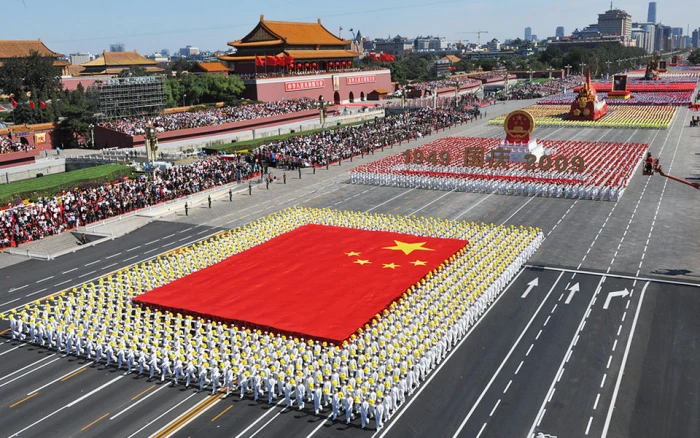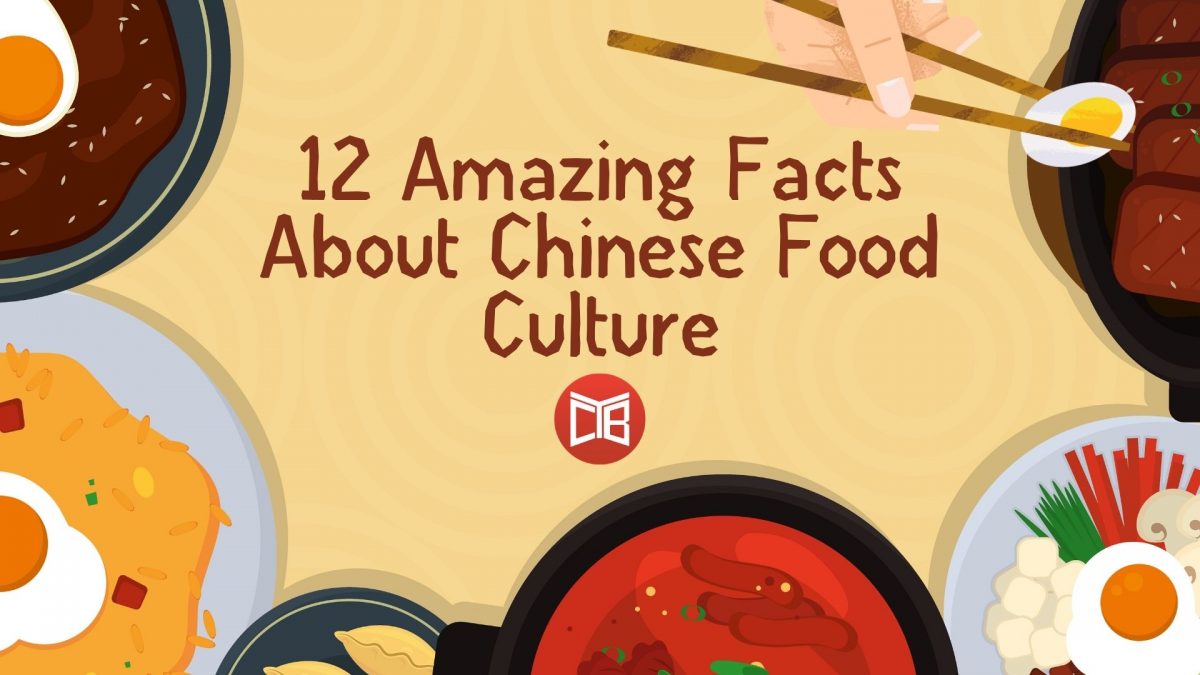
China’s rich geographical terrain that covers mountains, dense forests, deserts and waterways gives rise to a huge variety of foods. Chinese food, when prepared authentically, is among the healthiest cuisines in the world. In this article, we explore the top 12 Chinese food facts, from food superstitions in China and regional specialties, to health benefits and the importance of presentation in Chinese cooking. If your only experience of Chinese food has been from restaurants and takeaways outside of China, you’re in for a delightful surprise!
Top 12 facts about Chinese food
1. The eight major culinary traditions in Chinese food
There are eight major culinary traditions in China, known as the “Eight Great Cuisines”. These culinary traditions each have their own characteristics, featuring local ingredients, preparation methods and distinct taste. China’s rich geography and ethnic makeup give rise to a vast array of flavors and traditions.
| China’s Eight Great Cuisines | Flavors | Popular Dishes |
| Sichuan | Spicy food often cooked with Sichuan peppercorns | Kung pao chicken, mapo tofu |
| Cantonese | Sweet flavors and bite-sized delights | Roasted duck, stir-fried beef |
| Anhui | Wild herbs and fresh vegetables, pungent aromas | Stinky Mandarin fish, fried hairy tofu |
| Shandong | Braised and rich-flavored dishes | Moo Shu pork, Shandong roast chicken |
| Fujian | Light, flavorful and a focus on umami taste | Hokkien fried rice, lychee pork |
| Jiangsu | Seafood and seasonal vegetables | Sweet and sour fish, brine-boiled duck |
| Hunan | Spicy and sour, lots of pickled vegetables | Stinky tofu, red braised pork |
| Zhejiang | Fresh and lightly flavored | Shao shrimp balls, dongpo pork |
2. Food is family, friends and community in China
In Chinese culture, food is used as a symbol of meaning dependent on occasion and context. Here are some Chinese food facts that highlight the importance of symbolism in Chinese culture.
- Dates. Couples will have children early.
- Peanuts. A symbol of longevity.
- Rice cakes. A promotion is on the horizon.
- Seaweed. Good wealth.
- Noodles. Health and longevity.
- Pear. Separation and going away (negative meaning).
- Chicken. Focusing on the past, as chickens scratch backwards (negative meaning during Chinese New Year celebrations).
3. A huge variety of vegetables
Typical Chinese food served abroad is often battered and fried with lots of salt, added sugars and preservatives. This leads to a lack of understanding of Chinese food being one of the healthiest cuisines in the world when prepared authentically. China is the world’s largest producer of vegetables, producing over 680 million metric tons of vegetables each year. China’s varied climate also gives rise to a wonderful array of vegetables, some of which you may never have encountered before! For example, have you heard of edible daylily or wood ear mushrooms?
Certain vegetables also play a key role in Traditional Chinese Medicine (TCM). Vegetables are often consumed for their health and medicinal properties in Chinese food culture. The Yin-Yang balance is significant in TCM, as people try to balance warming vegetables and spices, such as onion and garlic, with cooling flavors, such as leafy greens and watermelon.
4. Superstition is important in Chinese food culture
With the importance of food in Chinese culture, it’s no surprise that this also gives rise to a wealth of superstitions. Symbolism in Chinese food culture dates back thousands of years, so it can be helpful to brush up on some of the dos and don’ts ahead of a trip to China!
Dos and don’ts in Chinese food culture
| Do | Don’t |
| Tap the table with your index and middle finger knuckles or fingertips to thank somebody for pouring tea. | Use your chopsticks or spoon to tap on your bowl or the table, this is seen as rude and unkempt. |
| Invite elders to eat before you. If whole fish is served, offer the eye to the eldest guest. For turtle soup, give the shell to the eldest guest. | Stick your chopsticks upright in your bowl of rice, this looks like a funeral incense bowl. |
| Leave some of your rice at a big celebration, it’s a sign of being full and thankful to your host. | Change seats when seated for dinner, this is a symbol that you will get divorced in the future. |
| Respect the seating hierarchy of the meal, with esteemed guests or elderly relatives occupying the most prestigious seats. | Eat directly from the dish, transfer the food to your bowl using your table chopsticks. |
| Take time to enjoy the range of food and don’t take too much. If you want to take the last mouthful of a dish, consult the table. | Dig into the dishes, this is seen as though you are desperate to search for your fortune. |
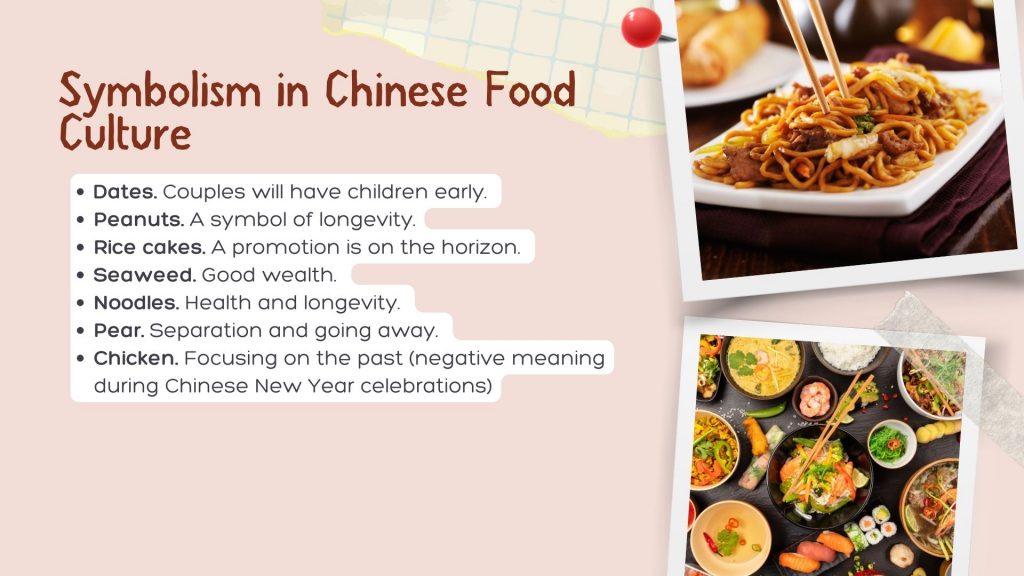
5. Rice, noodles, dumplings, steamed buns. A north-south divide?
The geographical environment and food cultures vary greatly between northern and southern regions in China. Rice is associated with southern China, whereas wheat-based carbohydrates such as noodles, dumplings and steamed buns hail from northern China. Although Chinese food culture has evolved with the passage of time, industrialization and globalization, regional disparity is still evident in Chinese cooking today.
6. Spices and seasoning are essential
In Chinese culture, it is often said that there are seven necessities of life: firewood, rice, oil, salt, sauce, vinegar and tea. Except for firewood, all the seven necessities are foodstuffs which demonstrates the importance of taste and flavor in Chinese food culture.
Top 15 Chinese spices and seasonings for cooking at home
If you are planning on cooking Chinese food at home, here are the top 15 spices and seasonings to keep stocked in your pantry!
- Spring onion
- Ginger
- Soy sauce
- Five-spice
- Garlic
- Chili pepper
- Oyster sauce
- Sesame oil
- Salt
- Rice vinegar
- Rice wine
- Soyabean paste
- Star anise
- Sichuan peppercorns
- Chili bean paste
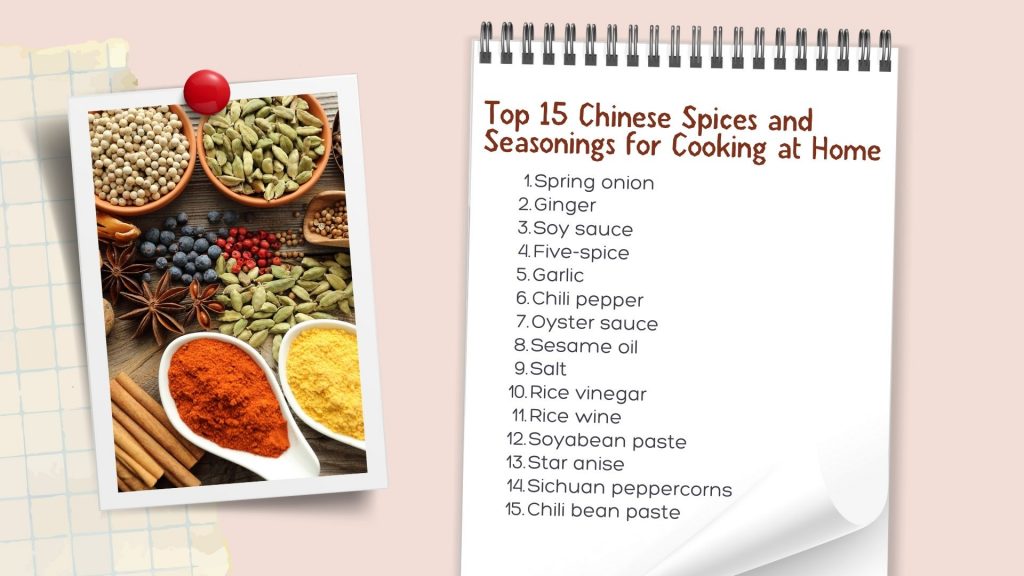
7. Chopsticks and bite-sized pieces
Chopsticks were first used in the Han Dynasty (206 B.C. – 220 A.D.) as rice consumption increased in China. During this period, rice was eaten with chopsticks but a spoon was still used alongside. It wasn’t until the Ming Dynasty (1,368 – 1,644 A.D.) that chopsticks were exclusively used for serving and eating, with a spoon still used for soup-based dishes.
Did you know? Over 45 billion pairs of disposable chopsticks are produced annually in China. Primarily, these are made from bamboo, birch, spruce and cottonwood. More on food waste in China later!
Eight rules for chopstick etiquette in China
There are eight key rules to observe when eating with chopsticks in Chinese food culture and symbolism goes way beyond simply picking up and eating food.
- Use your table chopsticks to pick up food from communal dishes. Once transferred to your rice bowl, you can eat with your main chopsticks.
- Don’t dig at food in communal dishes. This is seen as rude and of a lower social standing.
- Use your chopstick holder to place your chopsticks when not eating. Harmony and respect are important in Chinese culture, so chopsticks should not be placed separately or at random places on the communal table.
- Don’t stick your chopsticks in your food. This is seen as a symbol of the incense burning at Chinese funerals.
- Don’t stab at or tear food apart with your chopsticks. This is seen as rude and Chinese food is served in bite-sized pieces to make for easy consumption with chopsticks.
- Don’t play with chopsticks or wave or point them to get someone’s attention. Chopsticks hold high significance in Chinese culture, so they should be used with respect.
- Don’t use your chopsticks to pull a communal dish towards you. Food is served on a round, rotating table, so wait your turn to receive dishes.
- Don’t pass food to another person using your chopsticks. Instead use a communal plate to pass food to another guest, to be polite and practice good hygiene.
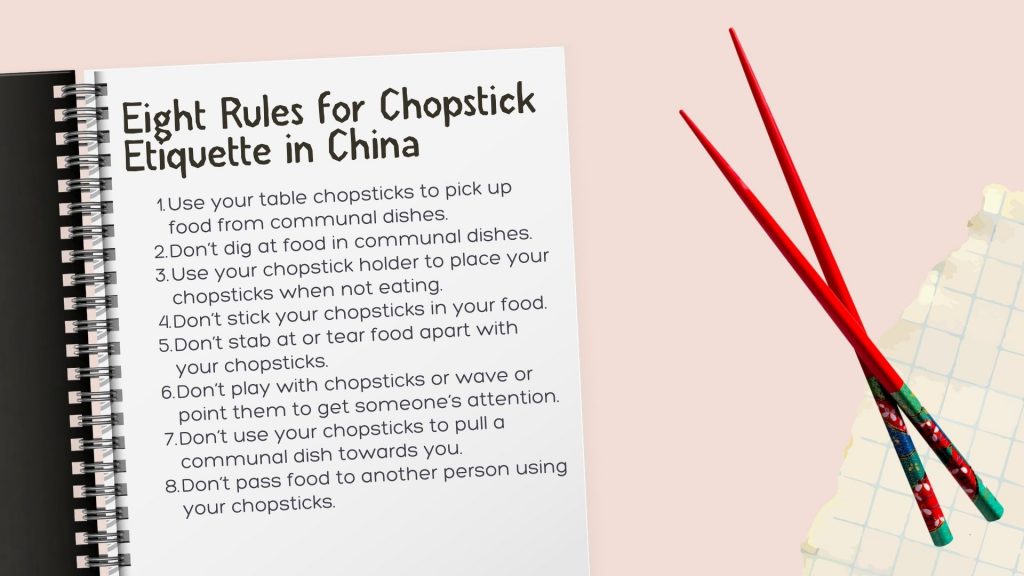
8. Presentation is key in Chinese food culture
Presentation is a key factor in Chinese food culture and is highly symbolic. Presentation is another area in which a north-south divide is evident in Chinese cooking. In northern China, dishes tend to be served colder so more time is spent in the arrangement and presentation. In southern China, key dishes are served hot straight away. Therefore, a key difference can be seen between the more decorative food in the north of China and the immediately served food in the south.
Presentation of food is also significant in TCM and again demonstrates the balance between Yin-Yang energy. Food is important not only to sustain life, but also to offer balanced, wholesome nutrition to your body and pleasure should be taken in the enjoyment of food.
9. Chinese vs. Western food culture
There are some key differences between Chinese and Western food cultures. The top eight differences are listed below.
Top eight differences between Western and Chinese food cultures
- Dishes are usually shared on a round, rotating table. Contrastingly to Western cultures, food is usually served communally on a round, rotating table. Guests enjoy all the dishes, rather than selecting their own.
- Food is served in bite-sized pieces. In China, food is generally served in bite-sized pieces that makes it easy to pick up with chopsticks.
- Unique ingredients. There is little waste in Chinese food culture, so internal organs and other weird Chinese food types are commonly served.
- Cooking styles. A wide variety of cooking styles are employed in Chinese cooking, such as steaming, stewing, sautéing, braising and wok-frying. Western food cultures tend to focus on frying, boiling, roasting and baking.
- Table sauces and spices. Salt, pepper, mustard, tomato sauce and mayonnaise are not offered on the table in Chinese restaurants. Instead, soy sauce, vinegar and chili oil will be offered to complement some dishes.
- Soup is served last. Soup is served last in Chinese food culture, contrasting to the soup starter in Western cooking. It is thought that soup after the main meal aids digestion!
- Watch out for bones. It is not common to remove bones in Chinese cooking, instead fish is cooked and served whole, whereas meat is chopped into small pieces still containing the bones to ensure it can still be eaten with chopsticks.
- Desserts are different. In the West, sweet desserts are often served after meals, whereas in Chinese culture fresh fruit and tea are more common.
10. Little to no waste in Chinese food culture
Chinese food culture is famed for its lack of waste and traditionally all edible part of animals, fish and vegetables are prepared and eaten. Even bone marrow is enjoyed in China, with pig tibia being served with a drinking straw to suck out and eat the bone marrow. In recent years, however, food waste has become a major issue in China, particularly among restaurants. In the past decade, China has placed great emphasis on reducing food waste with initiatives such as the “Clean Plate” campaign.
11. Top 10 Weird Chinese foods
Beyond daylily or wood ear mushrooms, there are also lots of other types of weird and wonderful foods in China. Here’s our lowdown on the top 10 you might encounter on your travels.
- Birds nest soup. Made from the nest of the swiftlet bird, which has a jelly-like consistency when cooked. Beijing National Stadium was even called “Bird’s Nest Stadium” when it was constructed for the 2008 Olympics.
- Chicken testicles. Taste like tofu when cooked and “pops” when eaten.
- Stinky tofu. A popular street food in China that can be smelt from streets away!
- Century egg. Also known as a hundred-year-old egg, preserved eggs are a popular delicacy in China.
- Pork floss. Made by stewing meat in a sweet mixture until the muscle fibers can be easily pulled apart with a fork.
- Duck intestines. The star delicacy in spicy hot pot meals to impress Chinese guests!
- Snakehead soup. Despite its name, snakehead soup is made using a fish that is boiled with traditional Chinese herbs.
- Bear paws. A rare historical Chinese delicacy, cooked in a soup.
- Bees. Bee pupae are enjoyed as a street food in China, with the bees at a stage of growth where they are contained within a cocoon.
- Jellyfish. Jelly-like texture and prepared as a salad.
12. What do Chinese people typically eat for breakfast?
Breakfast is a very important meals in Chinese food culture, as it keeps you energized for the rest of your day. From sunrise in China, you can find street vendors selling all types of delicious (if sometimes unhealthy) breakfast foods. Typical Chinese breakfast foods differ between the wheat-growing region in the north and the rice-growing region in the south. In northern China, breakfasts of steamed buns deep-fried dough sticks are popular. Rice noodles and baked sweet potatoes are more common in southern China as breakfast choices.
Conclusion
Authentic Chinese food is not only delicious, but also steeped in history, tradition and regional customs. Chinese food culture is also rooted in health and symbolism, often utilizing all parts of ingredients to minimize waste. We hope you have enjoyed this exploration into the facts about Chinese food culture and wish you all the best on your Chinese culinary journey!
FAQ
- What are the eight major culinary traditions in Chinese food culture? Sichuan, Cantonese, Anhui, Shandong, Fujian, Jiangsu, Hunan and Zhejiang.
- Why is food served communally in China? Food is a social experience in China and is used to develop relationships between people.
- Why is Chinese food eaten with chopsticks? Chopstick use is symbolic in Chinese culture and promotes shared experience, unity and respects traditions.
- How are seating positions chosen when eating in China? The eldest or guest with the highest standing face the entrance and occupy the most central position at the table. Guests then sit at distances from the most esteemed guest, in hierarchical or age order.
- Is there a lot of waste in Chinese food culture? Traditionally, there was little to no waste in Chinese cooking. Industrialization and the rise of dine-out culture has given rise to extreme food waste in China in recent decades.
Author
Sean studied Chinese and Spanish at University of Leeds and founded The Chairman’s Bao alongside Tom Reid in his final year of study in 2015. Current Managing Director of The Chairman’s Bao, he has overseen the company’s growth from university bedroom concept to an international force in the EdTech industry with over 200,000 individual users and over 400 global partner institutions. Sean also launched Newsdle alongside Tom Reid and Oliver Leach in 2021, for students and teachers of Spanish and French. In his spare time, Sean is still a keen language learner and runner. He also sits on the Board of charity Leeds Irish Health and Homes in the UK.






